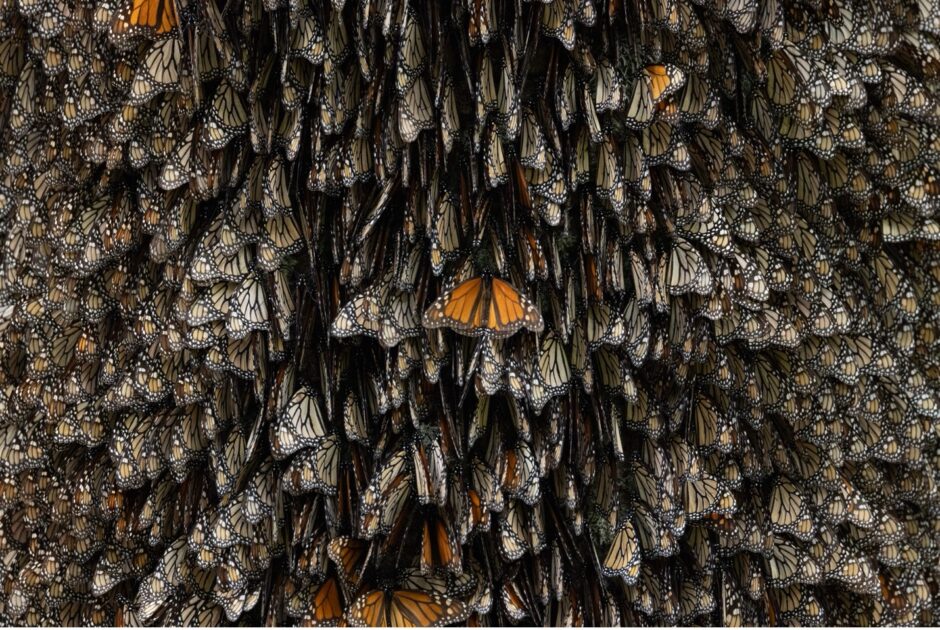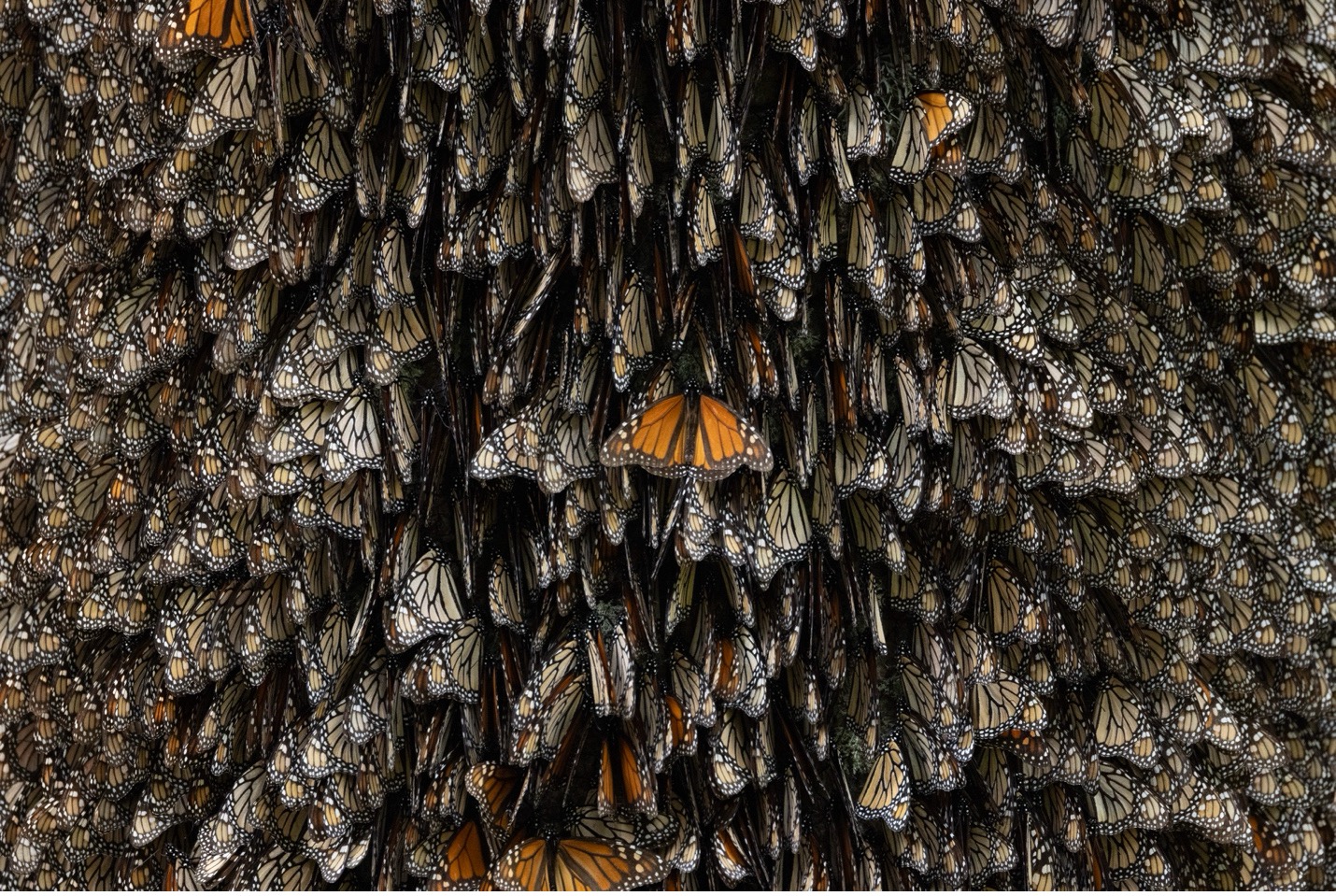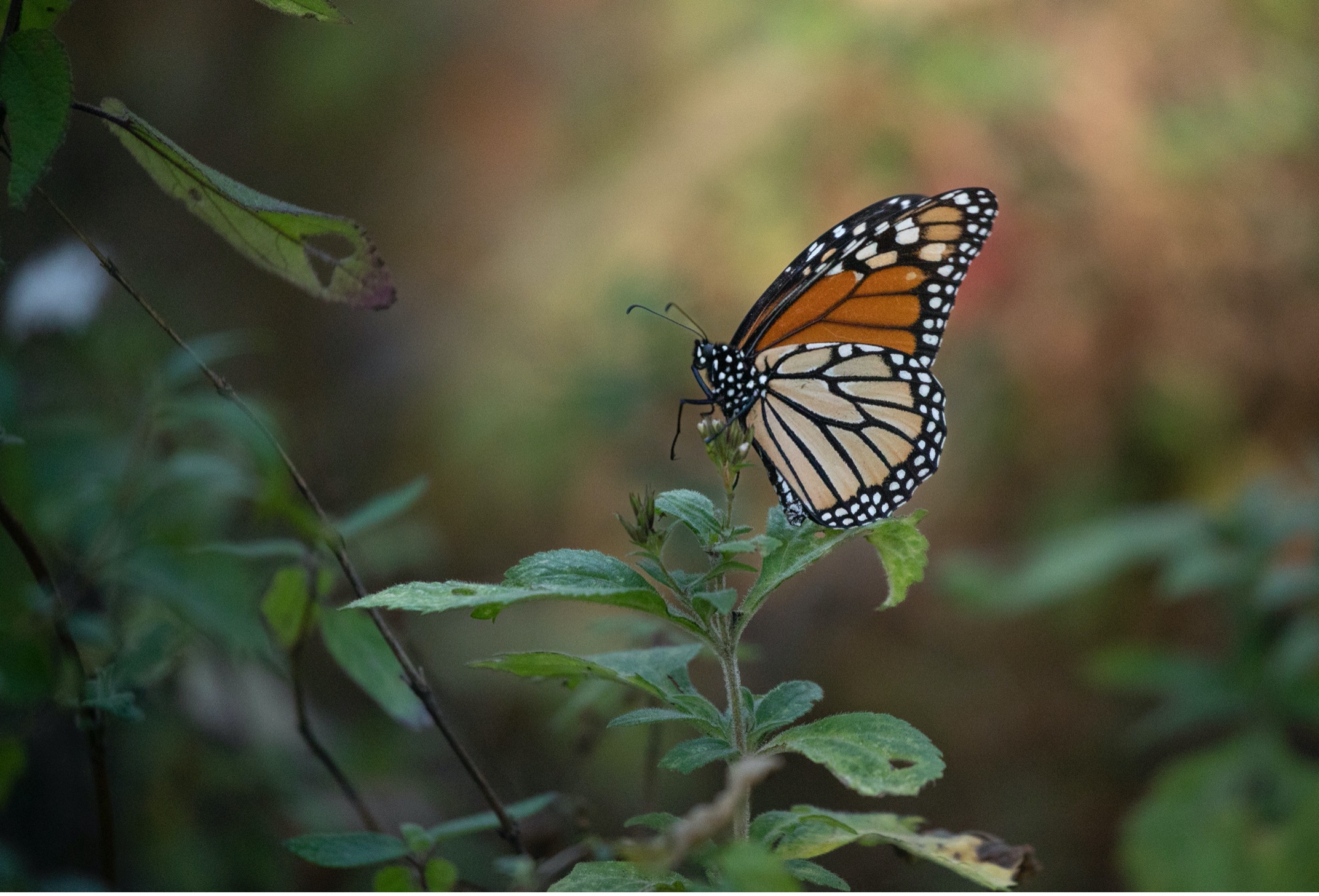
How to Get This Shot – Layers of Monarchs on Tree Trunk
If you know me, you know that photographing the monarch butterfly migration has been a cornerstone to my photographic (and guiding) career for over 20 years. Thus, I’ve seen lots of scenes in the overwintering colonies and have managed to photograph them in 100s of different ways. However, one of my favorite shots to aim for is where monarchs are covering every inch of a tree trunk–from edge to edge of your frame! And if I’m lucky, there will be at least one with its bright orange wings just starting to open to make a great photo.
Follow these tips if you’re headed on a Monarch Migration Photo Expedition to capture something just like this yourself!

Be Prepared with the Right Gear
It surprises a lot of people when I say that my go-to, most used lens for photographing monarchs is a big telephoto. It’s easy to think that with butterflies everywhere, all one would need is a ‘kit’ lens like an 18-55mm or 24-105mm. While those are great, too, if I could only take one lens it would definitely be the 100-400mm (or now 100-500mm, since Canon came out with that extended range) class of lenses.
To get a shot like the above, you really need to zoom in so that you can fill the frame with butterflies. Without that 400mm (or even 500mm range) you just won’t get the same effect.
If you are shooting on a point-and-shoot camera, that’s great, too, as they typically have zoom ranges at the 10-20x level, which gets you to where you need to be (and likely beyond!).
Finding the Right Tree
In the glorious monarch colonies, there are many trees with monarchs on them. However, some might be out of range, or require you to photograph up into the sky–not ideal. You must look for a tree that is somewhat at eye level, and with a pro photo guide, you’ll likely find one within moments of arriving into the monarch colonies.
However, and this is where having a beefy telephoto is key, it may not be the tree closest to you. You may have to shoot from 20, 40, or even 60 yards away.
The other aspect of finding the right tree is that you need to find a cluster of monarchs, like the one in the photo, that is evenly lit. I prefer if they are all shaded, so that I don’t get any super bright or super dark areas in the scene.
Let your camera do the exposing for you—you just need to make sure they are all lit evenly. In other words, if half of them are hit with a beam of sun, that’s not going to work the same. Similarly, if they are all in the sun, it’s just an entirely different look. Not only will all of their wings be open (likely), but you will definitely get shadows and highlights that are rather distracting.
Using the Right Settings
When filling the frame with monarchs, you actually need a deep depth of field. Something like f/2.8 or even f/4 won’t likely cut it. You will get the closer monarchs in focus with those even slightly behind being noticeably out of focus.
A shallow depth of field can be a beautiful thing for wildlife portraits, and even monarch photos, like in the below.

But for this shot, we actually need something like f/7.1 or even f/8 and greater. This allows the entire frame to be in sharp focus—the essence of this shot.
Because we need to prioritize for a deep depth of field and bigger f/number like f/8, our shutter speed and ISO are just a means to an end. However, we do need to be cognizant of shutter speed in order to a) freeze our own hand movement and b) freeze the monarch movement.
Part of the brilliance of this shot is that the monarchs aren’t likely moving too much. However, a sudden twitch of the wings could introduce unwanted blur. Part of the strategy here is to shoot fast enough to freeze slight motion, but the other part is trying to time it so that the monarchs aren’t moving. Something like a shutter speed between 1/200 to 1/400 should be enough.
In the case of this photo, one single monarch was waking up for the day and I was able to take a number of shots (some of them blurred) so that at least one turned out with “the main monarch” motionless for that lovely moment in time.
Because we’re trying to shoot in the shade, you may be surprised at how high of an ISO you need for the deep depth of field and moderately fast shutter speed (again, something like 1/200 to 1/400). Expect to use ISO 800, 1600, 3200, or perhaps even higher. Of course the lower the ISO the better, but photographing monarchs in the shade, as deep depth of field, will require higher-than-expected ISOs.
Timing it, Composition and Taking Multiple Shots
As I mentioned above, getting the single monarch opening its wings is a lovely x-factor for this photo. It will take careful attention, but it can be done. Usually this behavior occurs at the end of the day, as monarchs are coming back to roost for the evening, or at the start of the day as monarchs are just “waking up.” It will take a little luck, but you can stack the deck in your favor by taking multiple shots with the intent of just catching that right moment.
When it comes to composition, if you are fortunate to get that lone monarch displaying its orange upperside, I like to center it in the middle of my frame. This tends to go against the rule-of-thirds, when we place things on the left or right of the frame. But this is where the symmetry and artistry come in. Because of the uniform pattern on all other sides of the monarch, along with the fact that we want to dramatically emphasize our one key subject, center-placement works extremely well here.
In Summary
There are oh-so-many ways to photograph the monarch migration, but a scene like this example photo is one of the most awe-inspiring and dramatic I’ve encountered in over 20 years of guiding in the monarch colonies. Beyond just encountering this special scene, making sure you prioritize the settings and take multiple, well-timed photos is essential.
And even better is to join a specialized Photo Expedition to the Monarch Colonies, where you’ll be joined by experts that know the ins and outs of how to capture the monarchs in all their glory.
Hope to see you there!

Court
Leave a reply